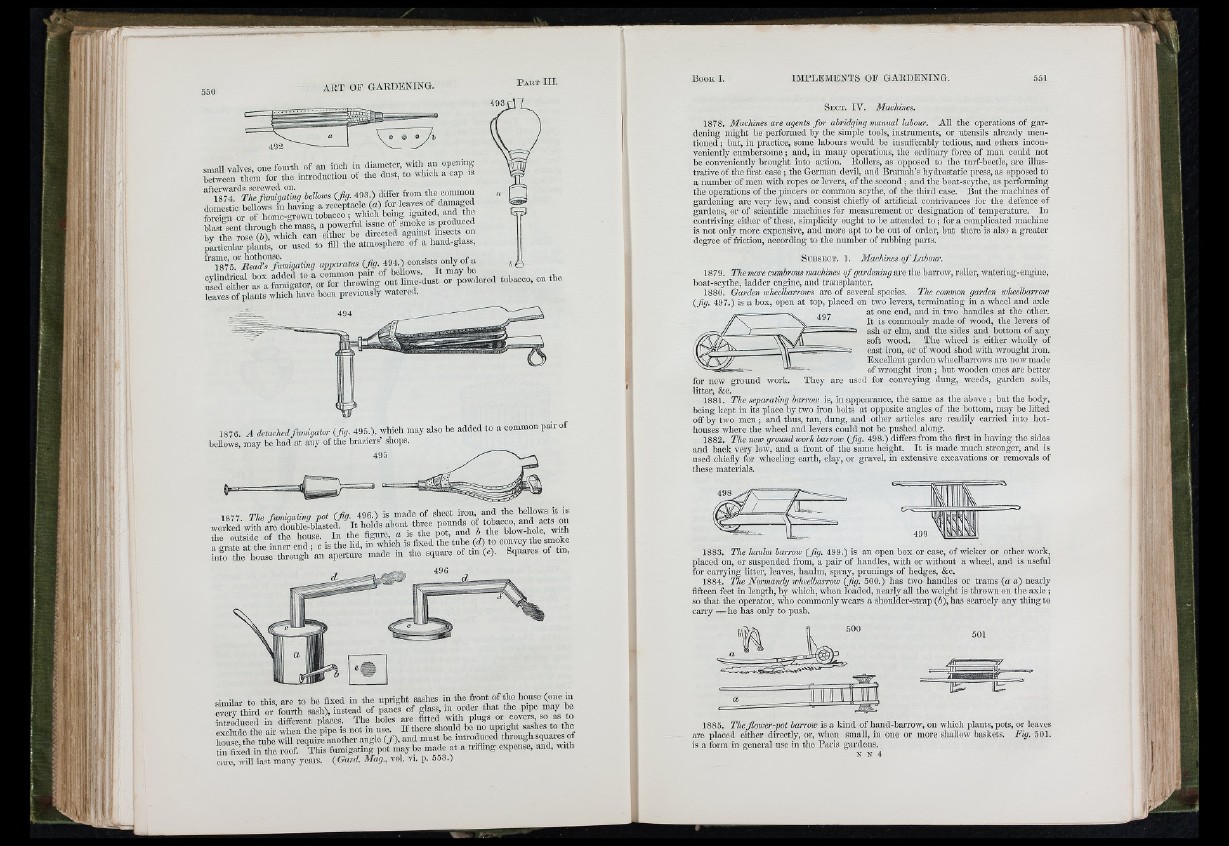
w .
«„lEdl valves, one fouvtli of an inch in diameter, with an opening
between them for tho introduction of the dust, to which a cap is
Tim fumigating bellows (fig. 493,) differ from tlie common
domestic bellows in having a receptacle (a ) for lea,ves of
forcio-n or of home-grown tobacco ; winch being ignited, and the
blasttaeut through the mass, a powerfttl issue of smoke is p iotaced
by the rose (b), which can either he directed against insects on
Lrticnlai- plants, or used to fill the atmosphere of a hand-glass,
apparatus (fig. f
M a » 7 7 or pLwdered tobacco, on the
leaves of plants which have been previously watered.
1876. A d e t a c h e d fuinigator {fig. 495.), Avhich may i
bcUows, may be bad at any of the braziers’ shops.
495
D be added to a common pair of
M r » cM e i s M M » M t » e » s ^
into the house through an aperture made m the square of tin (e). Squares of tm,
tL
suuilar to this, are to be fixed in the upright sashes in the fi-ont of the house (one in
evciT third or fourth sash), instead of panes of glass, in order that tbe pipe may be
introduced in different places. The holes are fitted with plugs or covers so as to
exclude the air when the pipe is not in use. I f there should be no n p nght sashes to the
S s f t e tube will require L t h e r angle ( / ) , and must be introchmed throngh squares of
till fixed in the roof. This fiimigating pot may bo made at a trifling expense, and, with
carc, will last many years. (Gard. Mag., vol. vi. p. o53.)
S e c t . IV. Machines.
1878. Machines are agents fo r abridging manual labour. All the operations of gardening
might be performed by the simple tools, instruments, or utensils already mentioned
; but, in practice, some labours would be insufferably tedious, and others inconveniently
cumbersome; and, in many operations, the ordinary force of man could not
be conveniently brought into action. Rollers, as opposed to the turf-beetle, are illustrative
of the first ca se ; tbe German deril, and Bramah’s hydrostatic press, as opposed to
a number of men with ropes or levers, of the second ; and tbe boat-scytlie, as performing
the operations of tbe pincers or common scythe, of the third case. But the machines of
gardening are very few, and consist chiefly of aitiiicial contrivances for tbe defence of
gardens, or of scientific machines for measm-ement or designation of temperature. In
contriving either of these, simplicity ought to be attended t o ; for a complicated macliine
is not only more expensive, and more apt to be out of order, but there is also a greater
degree of fiiction, according to the number of mbbing parts.
S u b s e c t . 1 . Machines o f Labour.
1879. Themore cumbrous machines o f gardening axe, \h& barrow, roller, Avatering-engiiie,
boat-scythe, ladder engine, and transplanter.
1880. Garden wheelbarrows are of several species. The common garden wheelbarrow
(fig. 497.) is a box, open at top, placed on two levers, terminating in a wheel and axle
at one end, and in two handles at the other.
It is commonly made of wood, the levers of
asli or elm, and the sides and bottom of any
soft wood. The wheel is either wholly of
cast iron, or of wood shod with wrought iron.
Excellent garden AvheelbaiTows are now made
of wrought iron ; hut wooden ones are better
for new ground work. They are used fur conveying dung, weeds, garden soils,
litter, &c.
1881. The separating barrow is, in appearance, the same as the aboA'e; but the body,
being kept in its place by two iron bolts at opposite angles of the bottom, may be lifted
off by two men ; and thus, tan, dung, and other articles are readily carried into hothouses
where the wheel and levers could not be pushed along.
1882. The new ground work barrow (fig. 498.) differs from the first in having the sides
and back very low, and a front of the same height. I t is made much stronger, and is
used chiefly for wheeling earth, clay, or gi-avel, in extensive excavations or removals of
these materials.
1883. The haulm harrow (fig. 499.) is an open box or case, of wicker or other Avork,
placed on, or suspended fi-om, a pair of handles, with or Avithout a wheel, and is useful
for carrying litter, leaves, haulm, spray, pmnings of hedges, &c.
1884. The Normandy wheelbarrow (fig. 500.) has two handles or trams (a a) nearly
fifteen feet in length, hj’’ which, Avhen loaded, nearly all the Aveight is thrown on the axle ;
so that the operator, avIio commonly wears a shoulder-strap (6), has scarcely any thing to
can-y — he has only to push.
501
1885. Tkejioiver-pot barrow is a kind of hand-barrow, on which plants, pots, or leaves
are placed either directly, or, Avlien small, in one or more shalloAv baskets. Fig. 501.
is a form in general use in the Paris gardens.
N N 4